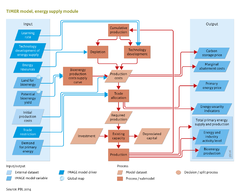Energy supply/Description: Difference between revisions
Jump to navigation
Jump to search
No edit summary |
No edit summary |
||
| Line 1: | Line 1: | ||
{{ComponentDescriptionTemplate | {{ComponentDescriptionTemplate | ||
|Status=On hold | |Status=On hold | ||
|Description= | |Description=<h>Fossil fuels and uranium</h> | ||
===Long-term depletion=== | ===Long-term depletion=== | ||
| Line 8: | Line 8: | ||
A key input for each of the fossil-fuel and uranium supply submodels is that of fuel demand (i.e. fuel used in final energy and conversion processes). Additional input consists of conversion losses in refining, liquefaction, conversion, and energy use within the energy system. In the submodels, it is indicated how demand can be met by supply, both within a region and from other regions through interregional trade. | A key input for each of the fossil-fuel and uranium supply submodels is that of fuel demand (i.e. fuel used in final energy and conversion processes). Additional input consists of conversion losses in refining, liquefaction, conversion, and energy use within the energy system. In the submodels, it is indicated how demand can be met by supply, both within a region and from other regions through interregional trade. | ||
{{Table ES|Table}} | {{Table ES.PNG|Table}} | ||
Table 4.1.3.2 provides an overview of the fossil-fuel categories, for illustrational purposes here aggregated into only 5 categories for each fuel. Each category (as indicated in the table) has its own typical production costs. The table indicates that the assumptions for oil and natural gas supply limit this supply to only 2 to 8 times the 1970–2005 production level, for all categories, up to current reserves of unconventional sources. Production estimates on other unconventional resources are much larger, albeit very speculative. For coal, even current reserves amount to almost 10 times the production level of the last three decades. For all fuels, the model assumes that, if prices would increase (or spectacular technology development takes place), the energy could be produced in the higher-cost resource categories. The values in Table 4.1.3.2. represent medium estimates in the model. The model can also use higher or lower estimates in the scenarios. The final production costs in each region are determined by the combined influence of resource depletion and learning-by-doing (for more information see backrgound information on [[Technical learning and depletion|resource depletion and 'learning by doing']]. | Table 4.1.3.2 provides an overview of the fossil-fuel categories, for illustrational purposes here aggregated into only 5 categories for each fuel. Each category (as indicated in the table) has its own typical production costs. The table indicates that the assumptions for oil and natural gas supply limit this supply to only 2 to 8 times the 1970–2005 production level, for all categories, up to current reserves of unconventional sources. Production estimates on other unconventional resources are much larger, albeit very speculative. For coal, even current reserves amount to almost 10 times the production level of the last three decades. For all fuels, the model assumes that, if prices would increase (or spectacular technology development takes place), the energy could be produced in the higher-cost resource categories. The values in Table 4.1.3.2. represent medium estimates in the model. The model can also use higher or lower estimates in the scenarios. The final production costs in each region are determined by the combined influence of resource depletion and learning-by-doing (for more information see backrgound information on [[Technical learning and depletion|resource depletion and 'learning by doing']]. | ||
| Line 29: | Line 29: | ||
2. Subsequently, the model assesses which part of the grid cell can be used for energy production, given its physical–geographical (terrain, habitation) and socio-geographical (location, acceptability) characteristics. This leads to an estimate of the geographical potential. Several of these factors are scenario-dependent. The geographical potential of biomass production from energy crops is estimated using suitability/availability factors accounting for competing land-use options and the harvested rain-fed yield of energy crops. | 2. Subsequently, the model assesses which part of the grid cell can be used for energy production, given its physical–geographical (terrain, habitation) and socio-geographical (location, acceptability) characteristics. This leads to an estimate of the geographical potential. Several of these factors are scenario-dependent. The geographical potential of biomass production from energy crops is estimated using suitability/availability factors accounting for competing land-use options and the harvested rain-fed yield of energy crops. | ||
3. Because only part of the energy can be extracted in the form of secondary energy carriers (fuel, electricity), due to limited conversion efficiency and maximum power density, part of the geographical potential cannot be used. This result of accounting for these conversion efficiencies is called the technical potential. | 3. Because only part of the energy can be extracted in the form of secondary energy carriers (fuel, electricity), due to limited conversion efficiency and maximum power density, part of the geographical potential cannot be used. This result of accounting for these conversion efficiencies is called the technical potential. | ||
4. The final step is to relate this technical potential to on-site production costs. Information at grid level is then sorted and used as supply cost curves, to reflect the assumption that the lowest cost locations are exploited first. Supply cost curves are used dynamically and change over time as a result of the learning effect. | 4. The final step is to relate this technical potential to on-site production costs. Information at grid level is then sorted and used as supply cost curves, to reflect the assumption that the lowest cost locations are exploited first. Supply cost curves are used dynamically and change over time as a result of the learning effect. | ||
}} | }} | ||
Revision as of 16:34, 9 December 2013
Parts of Energy supply/Description
| Component is implemented in: |
|
| Related IMAGE components |
| Projects/Applications |
| Key publications |
| References |
